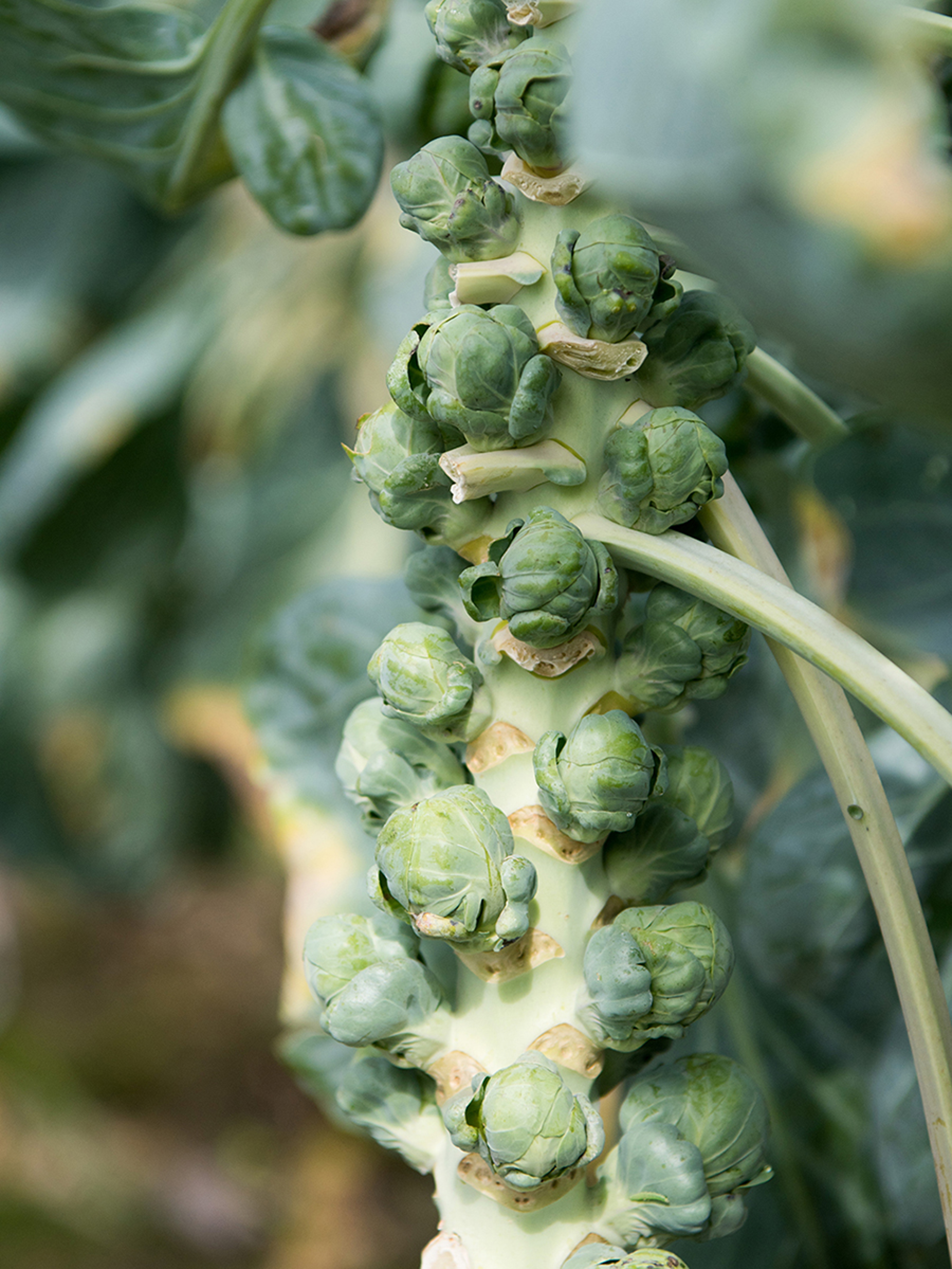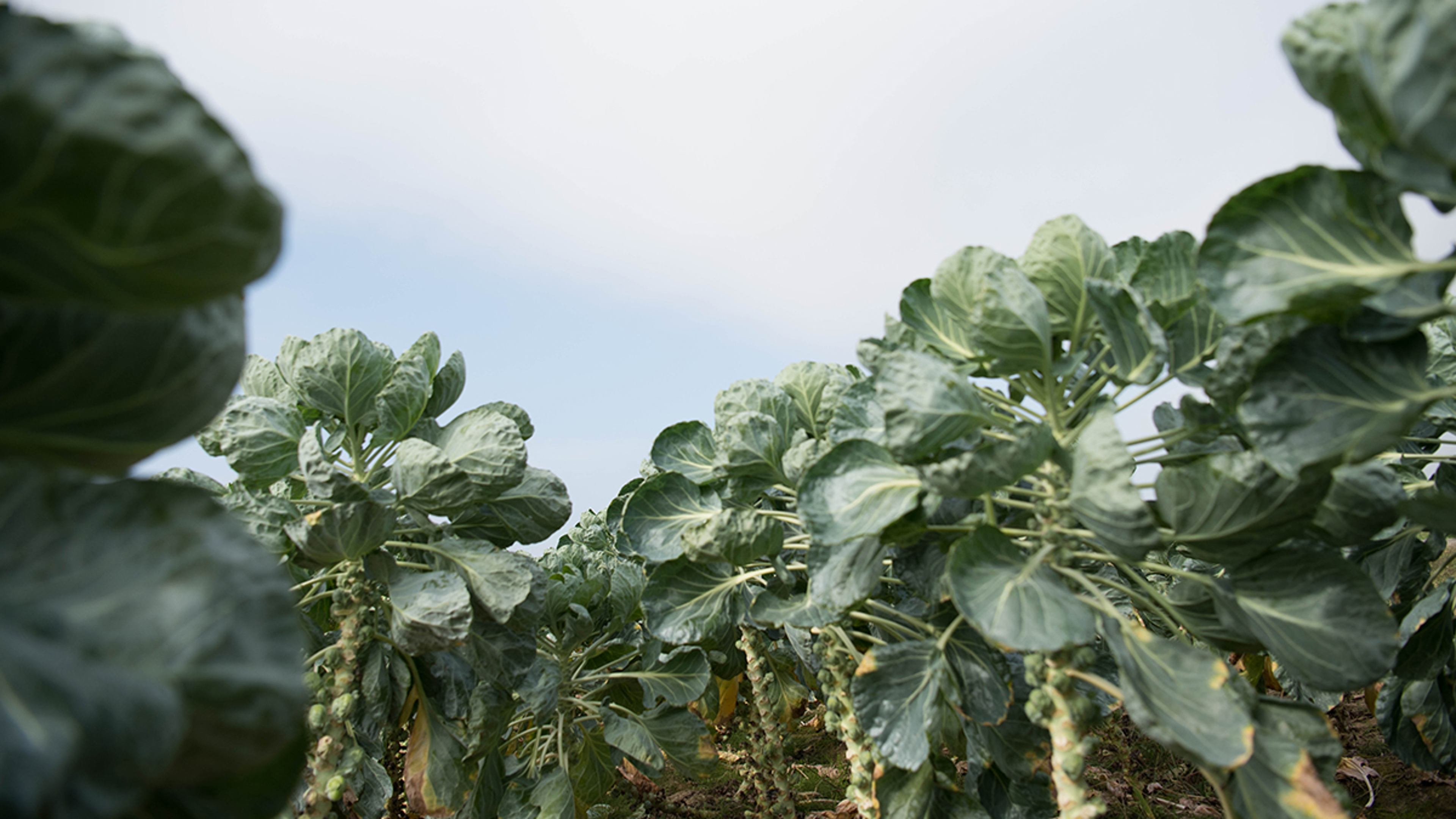November's Veg of the Month: Brussels Sprouts
Brussels sprouts have a reputation for being bitter. But how can you say that about a luscious vegetable that's actually nutty and savory?
Sep 30, 2023
At the heart of The Chef's Garden's mission lies a deep-rooted commitment to replenishing the land's vitality rather than merely extracting from it. And its harmonious relationship between land and farmer translates into nutrient-dense, flavorful produce that offers unparalleled benefits to the soil and our health.
"Our care of the environment and the species we share it with is important," Farmer Lee Jones says. "And just as cultures around the world utilize every part of an animal in their cooking, at The Chef's Garden, we revere the vegetable plant by utilizing every part of it— every stage of a plant's life offers something unique to the plate," he says joyfully.

And this season, there is no more interesting, delicious, and satisfying plant than Brussels sprouts on their stalks.
Farmer Lee starts growing his Brussels sprout plants in the greenhouse. Then, in April, he transplants them to the field, where they reach 4 1/2 feet tall!
"Their beautiful leaves that run the length of the stalk provide a natural umbrella to protect the sprouts from the spring and summer sun," he explains. "We wait until the first frost to harvest them, since colder temperatures bring the natural sugar levels out in the plant, making them taste nutty and cabbage like."
And the entire plant — sprouts, leaves, and stalks — is eatable.
"In a blindfolded taste test, I bet you can't tell the difference between a Brussels sprout leaf and a collard green," Farmer Lee laughs. Both greens are in the cruciferous family and share mild, earthy flavor profiles. And though the stalk is fibrous, it is deeply flavorful, and its chewy texture turns silky when pureed with a touch of cream and butter, as you would prepare mashed potatoes.
And Farmer Lee's forward thinking veggie preparations don't stop at the stove.
"Slice another stalk and use it as a vessel to present the Brussels sprout puree," he offers. Magnificent!
What makes The Chef's Garden Brussels sprouts special?
When we chew or chop cruciferous vegetables like Brussels sprouts, we help release a potent compound called sulforaphane. This phytochemical helps support heart health and cancer prevention by neutralizing free radicals. To maximize sulforaphane production, cut or chop Brussels sprouts 30 minutes ahead of cooking. If you don't have that much time, adding mustard seed powder to cooked cruciferous vegetables, such as broccoli and collard greens, helps optimize the compound and imparts a fresh aroma and a sharp, pleasing mustard flavor.
The Chef's Garden sprouts have no bitterness and are mellow and full of nutty flavor. When harvested after a frost, they have been compared to grapes from a fine ice wine.

How to use fall Brussels sprouts
Steaming, roasting, and sautéing are tried-and-true cooking methods for these little cabbage-looking wonders.
"Caramelizing Brussels sprouts in a pan with balsamic vinegar is most popular," Farmer Lee says. The sweet, bright, syrupy vinegar adds zing!
Still, steaming Brussels sprouts is a healthy, oil-free method that minimizes nutrient loss. And try roasting Brussels sprouts with a mélange of seasonal vegetables in a 400-degree oven. "This gives the leaves a good crisp, which adds texture to a vegetable appetizer plate," he adds.
And here is a tip: Cut sprouts the same size so they cook evenly; you can leave tiny sprouts whole and halve or quarter any larger sprouts.
While Brussels sprouts are a great side dish for almost any protein, including scallops and steak, you can serve them raw, too. Thinly slice, shred, or shave the sprouts on a mandolin, and add them to a fall kale salad or quickly sauté them in olive oil for a quick side dish — they will be juicy! And Brussels sprout slaw makes a great sandwich topper. Or trim the bottoms, then use your hands to pull apart whole Brussels sprouts and roast the leaves to make crispy chips. Red and purple Brussels sprouts retain some color but will bleed into the pan when cooked with liquid, such as white wine or broth.
How to care for and store Brussels sprouts
Look for firm Brussels sprouts with tight heads and not much browning at the base, and avoid yellowing sprouts. And do be sure to smell them: They should have a fresh smell that's not overly cabbagey. Refrigerate loose sprouts unwashed. You can wrap them in a bag or an air-tight container for up to three days; they lose their sweetness and nutritional value after much longer.
"Better yet," Farmer Lee says, "purchase sprouts sold on the stalks!" If the sprouts are on a stalk, wrap them in a couple of plastic bags for up to a week. Remove any yellow outer leaves and trim the base if it's tough or browned. Rinse them in cold water and shake or pat dry. Remove and store any loose outer leaves — they will crisp when roasted.
.svg?q=70&width=384&auto=webp)



















